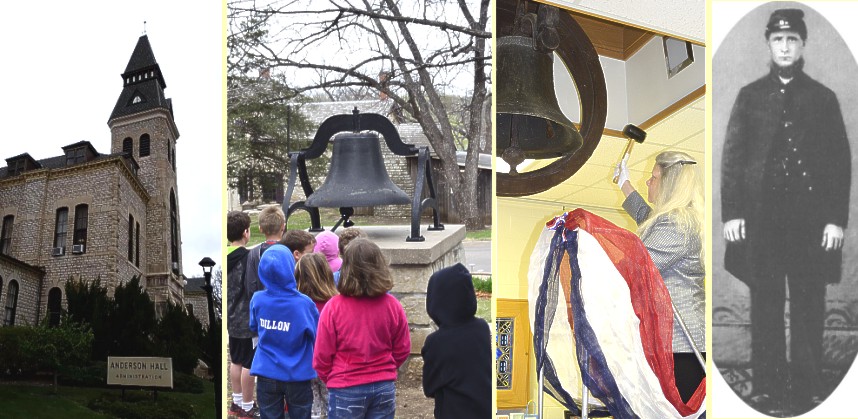Kansas Snapshots by Gloria Freeland - April 17, 2015
For whom the bells tolled
At 2:15 in the afternoon last Thursday, the carillon in Kansas State University's Anderson Hall tower began tolling.
The sound seemed to ebb and flow with the brisk spring gusts. The few others within sight seemed more intent on
escaping the cool winds than noticing the chimes.
At the Riley County Historical Museum, the steamboat Hartford bell and the Bala Presbyterian Bell pealed for four
minutes. Volunteers at the Rocky Ford School rang its bell.
At that same moment 150 years ago - April 9, 1865 - Confederate Gen. Robert E. Lee surrendered to
Union Gen. Ulysses S. Grant at Appomattox, Virginia. The surrender signaled the beginning of the end for America's
Civil War that killed more than 750,000 Americans.
Thursday's "Bells Across the Land" commemoration was sponsored by the National Parks Service. Bells rang for four
minutes - a minute for each year the conflict raged - to recognize those killed, celebrate a restored nation and
mark the next step in the struggle for civil rights.
While it was blustery, daughter Mariya and I listened, standing on the recently-completed limestone plaza east of
Anderson Hall. The plaza commemorates K-State's founding in 1863 by an act of Congress - a Congress looking to the
future while the nation was still embroiled in war.
Although some Americans might find it difficult to relate to a war that happened so long ago, most would likely
find family members who were involved. In my family, my great-great-grandmother Mary Shannon's brothers Robert, Archibald
and Glasgow were Union soldiers. Their letters to loved ones included descriptions of battles and living conditions.
A letter from Robert to Archibald on July 4, 1864, described the aftermath of one skirmish:
...they had sharp sticks stuck up all along, so we could not get over... After we got them nearly surrounded,
they left and went on the ground where we made the charge and I saw trees that were from six to ten inches thick that
were cut down with our musket balls. There was not a tree but what was filled with bullets. It was the awfulest sight
I ever saw. Some of our men got killed right close to the rebs works, and we couldn't get them until they smelt so
bad that the rebs could not stand it, and then sent out a flag of truce to let us come and bury our dead...
On Oct. 22, 1864, Glasgow wrote to his parents, Robert and Rose Shannon:
...Its nothing to walk all day, but when you come to carry 50 rounds of cartridges, and five days rations,
knapsack as full as it can stick, it is a little different. I didn't hardly know how to walk when I took them all
off...
Husband Art had many in the conflict - Milo, Philo, Judson and Charlie Sheldon, Evan Vaughan, Oscar, Carl and
Reinhardt Graetz and Ira Cannaday.
Two of those - Philo Sheldon and Ira Cannaday - played important roles in Art's family history. Philo joined
Company I of New York's 60th Infantry Regiment in December 1863, and was wounded at Gettysburg. He and Clara Andrews,
a widow of soldier Daniel Van Dyke who was captured and died in prison, later married and raised a large family. Among
their children was Alma Sheldon, Art's grandmother.
Ira had married Sarah Crane in 1848 in New York. They had six children by the time they left for Wisconsin in 1861.
They settled onto a rented farm and had another son in October 1863. The following spring, Ira joined Company B of the
Wisconsin 38th Infantry Regiment. On June 11, 1864, he wrote a letter to Sarah from Mower U.S. Hospital in
Pennsylvania:
... Our regiment is in the front as near as I can learn of the battle of the Potomac, where the fighting is
going on daily. How long I shall stay here is uncertain. It depends all upon the condition of my health. As soon as I
get well and strong enough, I shall be sent to my regiment again to partake of the reality there is in the powder and
ball... Here I am getting better of the neuralgia, but my stomach and bowels are very much out of order yet. My
appetite is quite poor, but I am in hopes that I shall get along if nothing else sets in. I also have the ground itch
saddled on me by camping on old camp bottom. Some call it the camp itch. It is one of the worst and most painful
diseases that a person ever had... I am not strong. I am very weak and nervous. I could not march nor handle a gun
twenty minutes without being completely overcome ...
On April 2, 1865 - five days before his 41st birthday and seven days before Lee surrendered - Ira's regiment was
involved in a charge on Fort Mahone near Petersburg, Virginia. Ira was shot in the face and died.
While Ira was in the service, Tom Vaughan, a single man, walked twice daily to his brother Evan's farm to take care
of the chores while Evan was in the service. His route would have taken him past the Cannaday farm. Two years after
Ira's death, his widow Sarah married Tom and they had three children of their own - Edward, William and Edgar. Edgar
was Art's grandfather.
A few Southern die-hards continued to skirmish after Lee's surrender. It wasn't until Aug. 20, 1866 that President
Andrew Johnson signed a peace proclamation officially ending the war.
And last Thursday, we paused for four minutes to remember.
